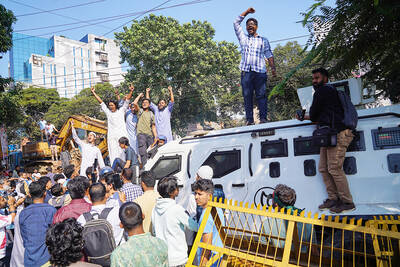Drawings of a nuclear warhead that Libya surrendered as part of its decision to renounce weapons of mass destruction are of 1960s Chinese design, but likely came from Pakistan, diplomats and experts told reporters on Sunday.
China is widely assumed to have been Pakistan's key supplier of much of the clandestine nuclear technology used to establish Islamabad as a nuclear power in 1998 and resold to rogue regimes through the black market network headed by Pakistani scientist Abdul Qadeer Khan.
The drawings appeared to be of a design never used by Pakistan, which went on to develop more modern nuclear weapons, said the diplomats and experts, who spoke on condition of anonymity.
Still, they said, they were likely supplied by China as part of the decades-long transfer of technology that Khan used to develop Pakistan's nuclear weapons.
One of them called the drawings "dramatic evidence" of the Chinese-Pakistani nuclear link.
Libya surrendered the drawings in December after its leader, Muammar Qaddafi, volunteered to scrap all research into developing weapons of mass destruction. The blueprints and accompanying documents are now in the US under the seal of the International Atomic Energy Agency (IAEA).
One of the experts said the drawing detailed how to build a warhead for a large ballistic missile, using technology developed by the Chinese in the 1960s that triggers a nuclear blast by a small conventional explosion.
While the instructions on the drawing were in English, some other documents surrendered by Libya along with the blueprints were in Chinese, he said.
He said that if built, the warhead would have weighed more than 450kg. That's too bulky for any delivery system the Libyans possessed but not for the ballistic missiles developed by North Korea and Iran, the other nations said to have been supplied by Khan's network.
While there is no evidence either of those countries were supplied with the same or a similar drawing, "it would be a very nice warhead for those countries," the expert said.
North Korea runs a nuclear weapons program using plutonium. But US officials also believe it has a separate program based on enriched uranium, possibly using technology imported from Pakistan. Pyongyang has denied the allegation.
Iran denies trying to develop nuclear weapons but suspicions persist because it kept secret attempts to enrich uranium for nearly two decades. Although it agreed to open all aspects of its nuclear activities to IAEA perusal late last year, the agency's inspectors recently found designs of advanced enriching equipment the Iranians had kept from them.
Critics say that Iran is not fully honoring an agreement to suspend uranium enrichment, something denied by Tehran, which says it is interested in the process not to make weapons-grade uranium but to generate nuclear power.
Pakistan -- and Khan -- became the focus of an international investigation on the basis of information Libya and Iran gave the Vienna-based IAEA about where they covertly bought nuclear technology that can be used to make weapons.
In the nuclear procurement chain that Khan has confessed to heading, hundreds of millions of dollars was thought to have changed hands over the past 15 years with key middlemen positioned in Europe, Asia, Africa and the Middle East.
Former nuclear weapons inspector David Albright said it was his understanding that the drawings found in Libya were "way beyond anything in the public domain" as far as building a warhead were concerned.
US President George W. Bush called the leaders of Russia and Italy on the weekend to discuss how to check the spread of dangerous weapons and keep them away from terrorists.

DISASTER: The Bangladesh Meteorological Department recorded a magnitude 5.7 and tremors reached as far as Kolkata, India, more than 300km away from the epicenter A powerful earthquake struck Bangladesh yesterday outside the crowded capital, Dhaka, killing at least five people and injuring about a hundred, the government said. The magnitude 5.5 quake struck at 10:38am near Narsingdi, Bangladesh, about 33km from Dhaka, the US Geological Survey (USGS) said. The earthquake sparked fear and chaos with many in the Muslim-majority nation of 170 million people at home on their day off. AFP reporters in Dhaka said they saw people weeping in the streets while others appeared shocked. Bangladesh Interim Leader Muhammad Yunus expressed his “deep shock and sorrow over the news of casualties in various districts.” At least five people,

LEFT AND RIGHT: Battling anti-incumbent, anticommunist sentiment, Jeanette Jara had a precarious lead over far-right Jose Antonio Kast as they look to the Dec. 14 run Leftist candidate Jeannette Jara and far-right leader Jose Antonio Kast are to go head-to-head in Chile’s presidential runoff after topping Sunday’s first round of voting in an election dominated by fears of violent crime. With 99 percent of the results counted, Jara, a 51-year-old communist running on behalf of an eight-party coalition, won 26.85 percent, compared with 23.93 percent for Kast, the Servel electoral service said. The election was dominated by deep concern over a surge in murders, kidnappings and extortion widely blamed on foreign crime gangs. Kast, 59, has vowed to build walls, fences and trenches along Chile’s border with Bolivia to

DEATH SENTENCE: The ousted leader said she was willing to attend a fresh trial outside Bangladesh where the ruling would not be a ‘foregone conclusion’ Bangladesh’s fugitive former prime minister Sheikh Hasina yesterday called the guilty verdict and death sentence in her crimes against humanity trial “biased and politically motivated.” Hasina, 78, defied court orders that she return from India to attend her trial about whether she ordered a deadly crackdown against the student-led uprising that ousted her. She was found guilty and sentenced to death earlier yesterday. “The verdicts announced against me have been made by a rigged tribunal established and presided over by an unelected government with no democratic mandate,” Hasina said in a statement issued from hiding in India. “They are biased and politically motivated,” she

It is one of the world’s most famous unsolved codes whose answer could sell for a fortune — but two US friends say they have already found the secret hidden by Kryptos. The S-shaped copper sculpture has baffled cryptography enthusiasts since its 1990 installation on the grounds of the CIA headquarters in Virginia, with three of its four messages deciphered so far. Yet K4, the final passage, has kept codebreakers scratching their heads. Sculptor Jim Sanborn, 80, has been so overwhelmed by guesses that he started charging US$50 for each response. Sanborn in August announced he would auction the 97-character solution to K4